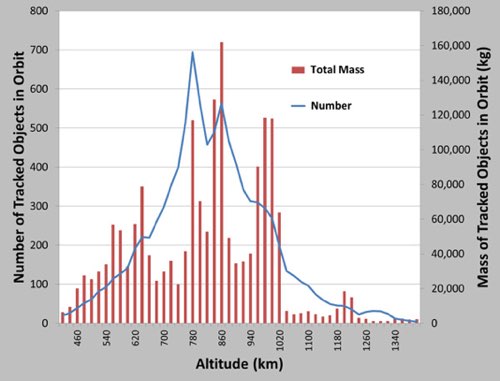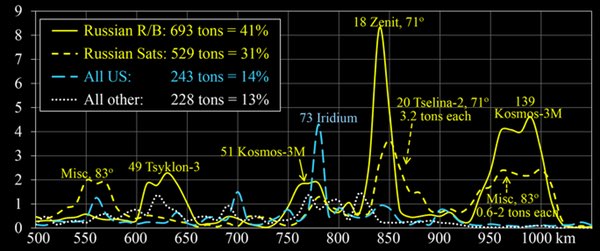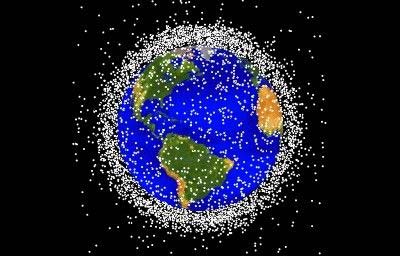Why the US and Russia should work together to clean up orbital debrisby Al Anzaldua and Dave Dunlop
|
| Is there a way that the Trump Administration can leverage such space cooperation to lower geopolitical tensions, while simultaneously removing a grave threat to our modern way of life and future space plans? |
Other areas of space cooperation between the powers through the years have been more mutually agreeable. Bilateral cooperation dates back to 1972, when the US and the Soviet Union initiated the Apollo-Soyuz Test Project, which culminated in the July 1975 docking of Soyuz 19 with an Apollo spacecraft. After the breakup of the Soviet Union in 1991, a new era of bilateral space collaboration started with the February 1995 flight of a space shuttle, whose crew included Russian cosmonaut Vladimir Titov, to the Mir space station. This was followed by Russian collaboration with the development and operations of the International Space Station (ISS), which continues to this day.
In the overall context of geopolitical tension between the US and Russia, it is striking and relevant that Russian president Vladimir Putin, in April 2016, said in a videoconference with the ISS crew, “We attach great importance that despite whatever difficulties we face on Earth, people in space work shoulder-to-shoulder, hand-in-hand, to help each other and fulfill tasks that are essential, not just for our countries, but for all of humanity” (US News 2016).
Given the unequivocal fact that space collaboration has been one relatively bright spot between the two otherwise adversarial powers, is there a way that the Trump Administration can leverage such space cooperation to lower geopolitical tensions, while simultaneously removing a grave threat to our modern way of life and future space plans? The answer is stark, if we would only look up.
Introducing an “opportune” crisis
Orbital debris is any human-made and uncontrollable litter left in Earth orbit. It includes inactive satellites, rocket stages, and fragments created by collisions, explosions, and even normal operations. There are over 22,000 Earth-orbiting debris objects larger than a softball (10 centimeters) and around a million shrapnel fragments between 0.5 and 10 centimeters (ESA 2013). With relative impact velocities reaching higher than 55,000 kilometers per hour in low Earth orbit (LEO—between 160 and 2,000 kilometers in altitude—even debris as small as a pea can take out spacecraft (Liou 2014).
The deliberate destruction in 2007 of the Chinese Fengyun satellite with an antisatellite weapon and the catastrophic 2009 collision between a defunct Russian Cosmos satellite and an operating Iridium satellite have together more than doubled the number of cataloged debris fragments (National Academy 2011). NASA, analyzing data from six space agencies, estimates that if nothing is done about the growing quantity of debris and increasing number of satellites in Earth orbit, there will be another catastrophic collision every five to nine years and the pace will accelerate (Liou 2014).
At least some who have been studying orbital debris for many years believe that we may have already reached a “tipping point” whereby orbital debris in congested LEO altitude bands is colliding in a runaway debris-generating cascade, often called the Kessler syndrome. Although this assertion is controversial, and a debris cascade would take years to unfold, at some point a Kessler cascade would nevertheless make spacecraft operation in affected altitude bands virtually impossible (McKnight 2012).
Orbital debris is an ever-growing hazard to the International Space Station (NASA 2015) and the approximately 1,300 operating satellites, which represent only six percent of the 22,000 tracked objects in orbit (Baiocchi 2015). Although about 70 countries operate satellite, the US, China, and Russia have the three largest fleets (Aerospace 2015) and thus have the most at risk.
| In considering international cooperation, it is high time that we move beyond tepid multilateral guidelines for orbital debris mitigation, and move on to orbital debris cleanup, or remediation. |
The ISS must maneuver one or more times a year to avoid collisions with debris (NASA 2015). Satellites in certain higher LEO orbits (see figure 1 below) face a much higher threat of collision. Even the satellites in geosynchronous orbit, at an altitude of more than 35,000 kilometers where relative collisional velocities are usually much lower, are nevertheless threatened by multi-ton debris bodies tumbling uncontrollably (Anselmo 2000).
The current risk to satellites, which provide commercial services worth over $200 billion annually for television, radio, telephone, search and rescue, weather and climate reporting, navigation, and national defense, varies with debris object number, mass, and potential impact velocity within an altitude and inclination band. Although it is difficult to determine what percentage of satellite failures are due to orbital debris strikes, as opposed to other causes such as meteoroid impacts, the increasing amount of orbital debris is undoubtedly a factor in annual economic losses in the satellite industry. In this regard, claims paid out by insurance companies for on-orbit spacecraft failures in 2013 reached $800 million (OECD 2014).
Large structures planned for Earth orbits, such as commercial space stations, tourism hotels, space solar power satellites, and staging and fueling platforms, will be especially vulnerable to orbital debris that will certainly grow from future collisions, even if we put no new spacecraft into Earth orbit. Yet, companies are planning constellations of hundreds or even thousands of satellites in LEO.
The authors have dealt with the daunting technical challenges to cleaning up orbital debris in previous articles and papers. They have likewise dealt with the first two non-technical challenges, i.e. adverse economic factors and legal barriers (NSS 2016). The focus here will be on the third non-technical challenge, geopolitical impediments, because therein lies our nation’s greatest opportunity for diminishing the current threat to our modern way of life and international order.
In considering international cooperation, it is high time that we move beyond tepid multilateral guidelines for orbital debris mitigation, and move on to orbital debris cleanup, or remediation (Liou 2010), either by active debris removal (ADR) or the rehabilitation of defunct spacecraft through on-orbit servicing systems. Servicing can entail refueling or repairing non-functioning spacecraft, or reusing parts of such spacecraft by attaching functioning modules to them. Remediation also includes the eventual possibility of recycling and re-tooling defunct spacecraft materials, such as metals and plastics, for on-orbit assembly and fabrication (NSS 2016).
Orbital bands with the largest number of objects pose the greatest current risk or threat to satellites. However, the orbital bands with the highest overall mass represent the greatest future threat, because more mass eventually generates more destructive collisional debris. Based on these criteria, and accounting only for trackable objects 10 centimeters or larger in LEO, orbits around 780 kilometers are currently the most hazardous, and orbits around 640 kilometers, 780 kilometers, 840–860 kilometers, and 920–1,000 kilometers pose the greatest future threat (McKnight 2012).
 Figure 1: Number of tracked objects in LEO and the total mass as a function of altitude. Image credit: Darren McKnight and Patrick Dingman. |
How Russia fits in
The ISS can serve as a testbed for emerging orbital debris cleanup technologies, while offering a multi-year avenue to engage the international community and overcome geopolitical rivalries, especially with Russia. However, the ISS is currently scheduled to operate only through 2024, with Russia considering then detaching some of its ISS modules for its own station. This future loss of cooperative engagement with Russia will be particularly unfortunate given that Russia and the United States have been the major producers of multi-ton orbiting objects, a major source of future debris in LEO.
| The ISS can serve as a testbed for emerging orbital debris cleanup technologies, while offering a multi-year avenue to engage the international community and overcome geopolitical rivalries, especially with Russia |
Launching governments, through their classification of technology as “secret” and their dual-use technology transfer rules, have shown themselves to be very sensitive about the characteristics and capabilities of their satellites, especially military ones. Therefore, to induce international cooperation to remove, repurpose, recycle, or rehabilitate large debris objects, it is best to start with much less sensitive, but still dangerous, upper stages (which mostly aluminum alloy tanks), which make up about half of the LEO debris mass. Although passivation—expelling remaining fuel and discharging batteries—now keeps such stages from exploding, they remain dangerous because of their uncontrolled and tumbling state. Even so, capturing aluminum tanks should be a lot less complicated than grabbing or manipulating satellites with solar arrays, antennas, or even nuclear reactors.
About 693 tons of the spent stages in LEO, representing 41 percent of multi-ton debris in LEO, consist of Russian rocket bodies (see Figure 2). Removing only Russian rocket bodies from LEO could reduce future shrapnel creation by nearly 62 percent. This exceeds the 48 percent reduction that would occur if all non-Russian mass were removed from LEO (Pearson 2014). Nevertheless, the authors urge that the US transparently begin developing technologies, through public-private Space Act Agreements, to remove or relocate into salvage orbits defunct US rocket bodies and dead satellites from LEO, which account for just over half of the non-Russian mass in LEO.
 Figure 2: LEO Mass Ownership, Tons/Km Altitude. Image credit: Joseph Carroll |
As the US government, in coordination with US companies, takes steps to clean up its own debris, the US should approach Russia for further bilateral collaboration in space. A good start would be for talks between Russia and the US on the range of space operations and safety considerations, i.e. space situational awareness (SSA), respective catalogs of space objects, national research and regulations for debris mitigation, conjunction analysis, and more. Ideally, these talks would lead to a US-Russia bilateral orbital debris remediation agreement, which could deal with about 86 percent of the mass in LEO.
Why stop with Russia? How China could participate
There is nothing for the US and other countries to lose and much to gain by reaching out to Russia to clean up orbital debris. The same goes for reaching out to China, which has recently been signing space agreements with Russia for cooperation in space. Although the 2011 Wolf amendment effectively bars NASA from engaging in bilateral space agreements with China, the legislation is counterproductive. After all, continuing to exclude China, the source of much orbital debris, from civil space cooperation will not prevent it from developing its own capabilities non-transparently.
| The consumers of government-provided and commercial satellite services and the political leaders who represent those consumers need to understand that they are in a “pay now or pay more later” situation. |
The authors therefore urge that the US Congress modify the Wolf amendment to allow cooperation with China on matters related to orbital debris. Congress should also consider allowing scientific exchanges with China in areas of overwhelming common interest such as planetary defense, space weather, disaster response, and environmental monitoring. For dealing with either country, provisions of the International Traffic in Arms Regulations (ITAR) may also need to be amended.
The 14-member Inter-Agency Space Debris Coordination Committee (IADC), which already includes Russian and Chinese agencies and NASA, and which has already published voluntary orbital debris mitigation guidelines, may be a good starting place to develop voluntary remediation (i.e. cleanup) guidelines. However, all spacefaring countries (including the public and private space-related entities within their borders), space-related intergovernmental entities, and emerging and extant commercial satellite companies eventually need to be included.
Conclusion
Developing and utilizing technology and multilateral entities for orbital debris cleanup is bound to be difficult and expensive, and thus beyond the means of any one country. If the past is any indication, public and private space entities will eventually pass on these costs, either through taxes or higher service fees, to the consumers of satellite services. However, the consumers of government-provided and commercial satellite services and the political leaders who represent those consumers need to understand that they are in a “pay now or pay more later” situation.
While we ponder orbital debris cleanup costs, it may help to realize that a fee of just one penny per dollar on satellite service bills worldwide would raise more than $1 billion annually—and this is before taking into account the thousands of additional satellites planned for launch in the coming years. No matter how well funded, however, cleaning up orbital debris will not be quick and easy. Space industry leaders worldwide would have to collaborate with one another to distribute funds for the development of technologies and multilateral systems to execute the cleanup. International guidelines and laws dealing with liability and responsibility for defunct orbiting bodies must also be clarified and further elaborated.
A lot of hard work lies ahead. On the other hand, if we wait until there are more catastrophic orbital collisions, we will not only suffer disruption to our satellite services, but the bill for a tardy cleanup will be much higher. Still, avoiding such catastrophe and economic hardship are not the only good reasons for immediately moving ahead on an international basis to clean up orbital debris. Taking on this threat now, beginning with bilateral and multilateral agreements, can be a way to calm dangerous geopolitical tensions while developing technology that can be used to tap the infinite resources of space for the benefit of all humanity.
References
Aerospace Technology. “The 10 countries most active in space,” 22 December 2015, www.aerospace-technology.com.
Anselmo, L; Pardini, C. “Collision Risk Mitigation in Geostationary Orbit,” Springer Link, June 2000, Volume 2, Issue 2, pgs. 67-82.
Baiocchi, Dave; Welser IV, William. “The Democratization of Space: New Actors Need New Rules,” Foreign Affairs, May/June 2015, pg. 103.
ESA. “Sixth European Conference on Space Debris: Background and Introduction,” p. 1, 22 – 25 April 2013. In this paper the European Space Agency (ESA) estimates that there are 700,000 debris objects in LEO between 1-10 cm. Because the number of debris objects increases greatly as the size of those objects decreases, the authors can safely estimate that there are probably about a million objects in LEO that can knock out a working satellite.
Liou, Jer-Chyi speaking at the 2014 NewSpace Conference Orbital Debris Panel on 26 July 2014.
Liou, J.-C.; Johnson, N.L.; Hill, N.M. “Controlling the growth of future LEO debris populations with active debris removal,” ActaAstronautica, Vol. 66, pgs. 648-653, March – April 2010.
McKnight, Darren; Kessler, Donald. “We’ve Already Passed the Tipping Point for Orbital Debris,” IEEE Spectrum, 26 September 2012.
NASA. “International Space Station Performs Two Debris Avoidance Maneuvers and a Shelter-in-Place,” NASA Orbital Debris Quarterly News, Volume 19, Issue 3, pgs. 1-2, July 2015.
National Academy of Sciences. “Limiting Future Collision Risk to Spacecraft: An Assessment of NASA’s Meteoroid and Orbital Debris Programs,” p. 1, September 2011.
National Space Society (NSS). “Orbital Debris: Overcoming Challenges,” May 2016. This NSS Position Paper comprehensively reviews all major technical and non-technical issues associated with the cleanup of orbital debris and offers 12 recommendations for action. Co-author Al Anzaldua was the lead author.
OECD. The Space Economy at a Glance 2014. “Insurance Market for Space Activities,” p. 76-77.
US News & World Report. “Russian President Vladimir Putin has highlighted Russia’s cooperation with the United States in space, despite all the difficulties the two countries face on Earth,” 12 April 2016.
